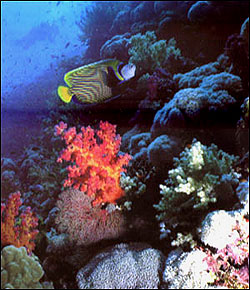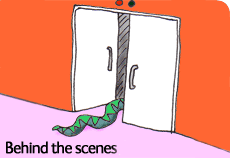Life on the reef
Linda Pitkin
Coral reef communities
Coral reefs are limestone structures formed by the skeletons of tiny animals that are similar to sea anemones. Corals belong to the order Scleractinia. Reef-building corals live in colonies that vary immensely in growth form but have one feature in common: they all contain zooxanthellae--symbiotic algae that supply coral with essential nutrients and colour--in their tissues. These minute algae play a vital role in reef construction. Like most green plants, they produce carbohydrates by photosynthesis, and it is this supply of nutrients that not only keeps their coral partners alive and well, but enables them to lay down rapid deposits for skeletal growth.
A coral reef is a community of many species: corals, other animals and plants. They all have their preferred sites, some colonizing the shallow zones and the outer reef, exposed to surge and currents, and others living in deeper or more sheltered regions. Even when the same species of coral lives in more than one zone, it may not look the same at different sites. Depth, light, water movement, temperature and water clarity are among the conditions that vary in different parts of a reef and affect the way in which a coral colony grows. Many corals are naturally long-lived, but they are intolerant of changes in their surroundings.

A coral reef community in the Indo-Pacific. (Image: Linda Pitkin)
Life on a reef is abundant in the shallows, but reef-building corals cannot live deeper than about 50 m (164 ft) because their zooxanthellae need sunlight. Corals require a water temperature of 18°C or more for reef formation and coral reefs are therefore essentially tropical. They are widespread in two main regions: the Indo-Pacific region from the Red Sea and South Africa to Polynesia, and the Western Atlantic region, the chief component of which is the Caribbean.
The coral reef ecosystem is highly complex, containing an amazing diversity of invertebrates (animals without backbones), fishes, and some other vertebrate animals, such as turtles. Although reefs cycle some nutrients to and from other environments, they are to a large extent self-contained systems, and are densely populated with inhabitants. Individuals, both of different species and of the same species, interact with each other in various ways, as predators, prey, competitors, mates or co-operative partners. Studies and observations have revealed fascinating aspects of their lifestyles, but much remains unknown, and many secretive small fishes and other animals are still being discovered.
Coral fish diversity
Coral fish communities are extremely diverse and dense on many tropical reefs, more so than in any other aquatic habitat. Over 4,000 fish species--nearly one-third of all known marine fish species--have been recorded on reefs. Some families of fish, such as butterflyfishes and damselfishes, are adapted to live primarily on coral reefs, while others, such as wrasses, have many members living in other habitats. Coral fishes live not only among the reef-building corals, but also with sea fans and soft corals, sponges and sea anemones. Some fishes rest on patches of sand or peep out of holes in the reef, others hover above the reef or swim actively, and visitors from the open ocean come in to prey on the residents.
Ready reference
Coral
Small, sedentary marine animal, related to the sea anemone but characterized by a skeleton of horny or calcareous material. The skeleton itself is also called 'coral'. Although most corals form colonies by budding, there are some solitary corals; in both types the individual animals, called 'polyps', resemble the sea anemone in form.
Corals grow in both warm and temperate climates, but they are most abundant in warm, shallow water; over 200 coral species are found in the Great Barrier Reef of Australia. In many shallow-water species, the polyps contain unicellular plants, which may provide the high oxygen concentration required by such corals.
How can a coral reef support so many fishes? This is made possible by the diverse lives that the fishes lead, specializing in various foods, and occupying different zones and habitats on and around the reef. The pressures of predation and competition are high and have given rise to immense variety in modes of life and behavioural ploys, and the physical adaptations needed to carry them out.
Coral fishes are not all active at the same time. Some feed during the daytime and retire to other sites to sleep at night, while others move out from daytime shelters to feed at night. Only a small minority are active on and off throughout day and night. When they are not feeding or breeding, most reef-dwellers hide from predators. Many fishes use the same refuges at different times of the day, making the most effective use of valuable space. Small fishes, such as blennies and gobies, do not tend to travel far, so their refuges and feeding sites are close together. Some large fishes, however, commute considerable distances--sometimes several kilometres--between resting and feeding places. Many form schools for safety when they are travelling, so that each individual fish runs less risk of being singled out by predators.
Coral fish taxonomy
Coral fishes are classified in more than 100 different families. The vast majority are bony fishes (fishes with a skeleton of bone) but a small minority are cartilaginous (fishes with a skeleton of cartilage). In the latter group are sharks and rays, a few species of which live on or around coral reefs. The fish families listed below are either particularly characteristic of coral reefs or are important in terms of numbers of reef species.
Major coral fish families
| Damselfishes and anemonefishes | Pomacentridae |
| Wrasses | Labridae |
| Parrotfishes | Scaridae |
| Surgeonfishes | Acunthuridae |
| Butterflyfishes | Chaetodontidae |
| Angelfishes | Pomacanthidae |
| Groupers and seabasses | Serranidae |
| Blennies | Blenniidae |
| Gobies | Gobiidae |
| Cardinalfishes | Apogonidae |
| Squirrelfishes and soldierfishes | Holocentridae |
| Grunts | Haemulidae |
Toolbox

Last year nearly 100,000 specimens were loaned to scientific institutions and researchers worldwide.